
Fire alarms are crucial components of any building’s safety infrastructure, providing early detection and warning in case of fire emergencies. Understanding how these life-saving devices work is essential to appreciating their role in safeguarding lives and property. In this article, we delve into the mechanics of a fire alarm system and its critical functions.
Detection Sensors
At the core of a fire alarm system are detection sensors that monitor the environment for signs of fire. There are various types of detection sensors, including smoke detectors, heat detectors, flame detectors, and gas detectors. Each sensor is designed to detect specific fire-related factors, such as the presence of smoke particles, high temperatures, or flames. When triggered, these sensors send signals to the control panel, initiating the alarm process.
The Control Panel
The control panel serves as the brain of the fire alarm system. It receives input from the detection sensors and processes the signals to determine if there is a fire or potential threat. Once a fire is detected, the control panel activates the alarm, which may include audible and visual alerts such as sirens and flashing lights. Some advanced fire alarm systems may also activate voice alarms or send alerts to monitoring stations or emergency responders.
Initiating the Alarm
When the control panel confirms the presence of a fire, it triggers the alarm devices throughout the building. These devices are strategically placed to ensure that the alarm is audible and visible from all areas, providing prompt evacuation warnings to occupants. The loud and distinct sound of the alarm is designed to alert people even in noisy or crowded environments.
Communication and Monitoring
In modern fire alarm systems, communication and monitoring play a significant role in enhancing safety. Some systems are connected to a central monitoring station, where trained operators receive alerts and can notify emergency services if needed. This connection ensures that authorities are promptly informed of any fire incidents, allowing for a rapid response, and minimising potential damage.
Manual Activation Points
In addition to automatic detection, fire alarm systems also include manual activation points, such as pull stations or break glass units. These devices enable individuals to initiate the alarm if they spot a fire or notice a potential hazard. Manual activation points are strategically placed near exits and escape routes, allowing for quick and easy access in case of emergencies.
The Role of Emergency Lighting
Fire alarms often work in conjunction with emergency lighting systems. During a fire emergency, smoke may obstruct visibility, making it challenging for occupants to find their way to safety. Emergency lighting provides illumination in darkened areas, guiding people to designated exits and safe evacuation points. Read more about the importance of emergency and security lighting here.
Regular Maintenance and Testing
To ensure the reliability of these systems, regular maintenance and testing are crucial. Routine inspections, testing, and servicing help identify and address any issues promptly, ensuring that the system functions optimally when needed. Building owners and managers should adhere to local regulations and codes, which often mandate periodic fire alarm system maintenance.
In conclusion, fire alarms and detection systems are integral to protecting lives and property. By detecting fires early, initiating alarms, and alerting occupants, these systems provide critical time for safe evacuation and emergency response. Regular maintenance and adherence to safety standards are essential to ensuring that fire alarm systems remain reliable and effective in safeguarding our communities. Partnering with us can help maintain and optimise fire alarm systems, contributing to a safer environment for all.
